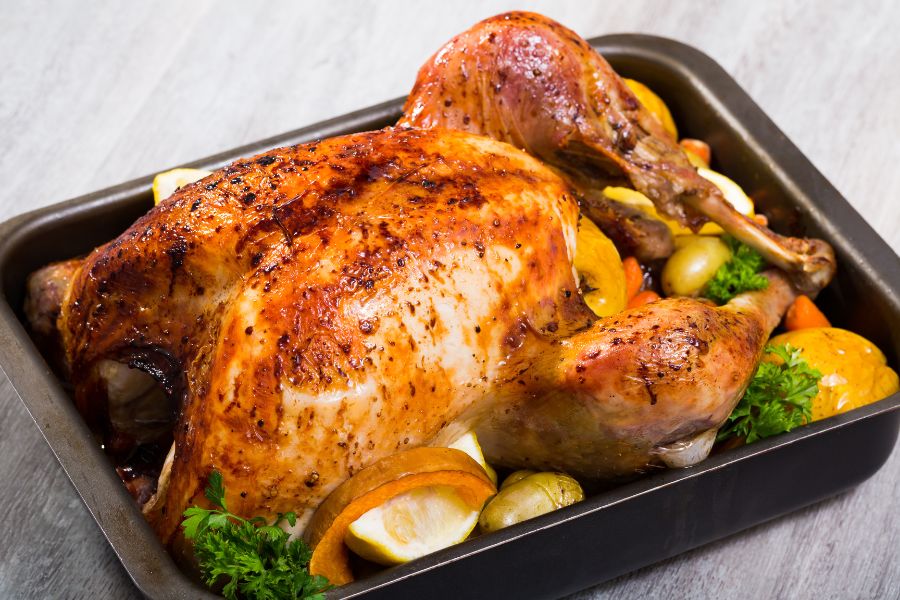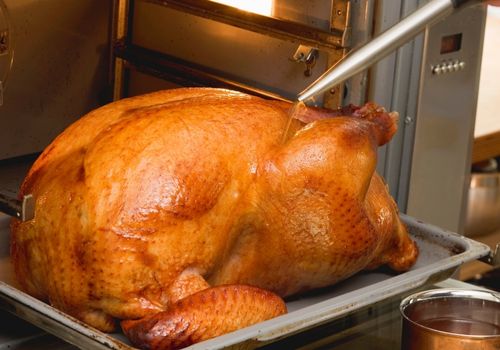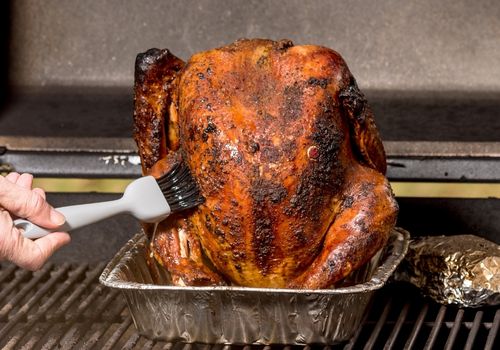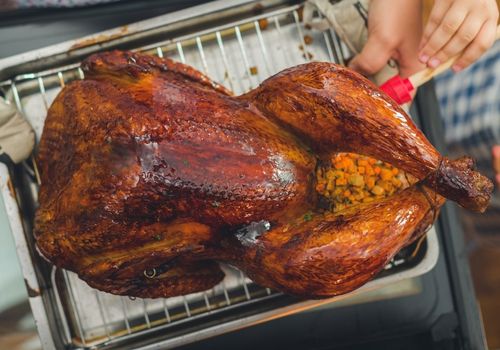Every 40 minutes! This is the general consensus among us cooks. With this interval, you won’t need to worry about over-basting your turkey or end up with dry meat.
Turkey is naturally not a juicy meat. It’s a dry meat because of its obviously low-fat content. This is why I welcome whatever technique out there that gets my turkey meat moist. Having experimented with various methods over the years (including drowning in gravy and brining), the basting technique is what I found to work best.
In this article, we’ll see what the ideal basting interval is and how to carry out the actual basting.

I advise scooping bastes on your birds every 40 minutes with a basting brush throughout the cooking procedure. It doesn’t matter whether you’re frying or making a smoked turkey.
A lot of recipes recommend basting once every hour or every half hour. However, at long basting intervals, they cause more heat loss than normal. With too-short basting intervals, you’ll have a longer cooking process because the basting procedure will reduce the temperature of your smoker or oven.
Don’t be worried if you’re a little late or early. However, following this requirement can help reduce the chances of having a dry turkey. Tender, juicy turkey breasts are often well-basted.
If you have a frozen turkey, first, you have to thaw it. Then, you need to wash the whole turkey, stuff the cavity and tie it up.
Turn on your cooker to an oven temperature of around 325 degrees. Then place the prepared turkey on a roasting tray/pan rack. This will let the turkey juices run into the bottom of your dish and make it easier to clean up after cooking.
Some folks prefer basting the turkey with the juices from the baking dish while others prepare a specific basting liquid mixture like chicken broth or melted butter to pour over the turkey. All of these options are perfectly acceptable and the choice is entirely up to you.
You need two timers!
The first one is the basting timer for timing the intervals between basting your turkey and anotherfor the cooking time. The cooking time will largely depend on the size of your turkey. For a large-sized turkey, you need a cooking time that ranges from 10 to 13 hours.
So, set your watering timer to ring every forty minutes and baste the turkey at this interval.
Pull your rack so that it is halfway out of your oven. Open the lid of your roasting tray or slightly remove the baking sheet that covers it.
Check the doneness of your meat. Is it starting to brown slightly? Perfect! Your turkey is ready to baste for the first time.
Some choose to baste their turkey every 20 minutes. A shorter interval will force you to stay close to your oven door. Imagine what the stress would be like when you have a large turkey that needs more than 12 cooking hours.

A turkey baster is a special rubber tool for sucking up and pouring liquids. It looks like a large, smooth syringe. In the absence of one, you can just as easily use a spoon or a cup for the turkey basting process.
Take the liquid you have prepared for the turkey basting process and gently pour it over the entire surface of your meat using a spoon or basting can. You can use broth, wine, butter, cooking oil, sauce, or juices. Don’t forget to add ingredients like brown sugar, thyme, garlic, and rosemary. The brown sugar, olive oil, melted butter, or both work for smoked turkey too. For some, olive oil is enough.
The idea is to keep your turkey tender. If you have herb butter mixture, marinade, or meat sauce, you can use that just as well.
Return your turkey to the baking dish. Set your timer again so that it rings in 40 minutes. You can go see an episode of your favorite series or read a book, but don’t go too far away.
Check for doneness and baste the meat with whatever liquid you have every forty minutes. You will quickly find cooking liquid in the bottom of your baking dish. You can now use it instead of the liquid you used to baste your turkey.
Whether you use the liquid from your meat or another liquid, the juices are now in your baking dish, infused with the juices from your delicious turkey, and ready to use again.
If your turkey touches your baking dish, you should squeeze out the excess juices. Your meat should not simmer in its own juices. This will make your meat too chewy instead of getting a golden, crispy turkey skin.
This is why it’s important to place your turkey on a small rack in your roasting tray or pan, as this will prevent it from soaking in its cooking juices.
You can use this juice for the base of your sauce. You can also pour it into a bowl that you will serve at the table with your other accompaniments such as vegetables, potatoes, etc. This juice has been infused for hours from the roasted turkey. It has a delicious taste of turkey. So don’t throw it away.
Instead of basting the turkey in its own basting liquid or basting mixture, there are other options for moistening a turkey recipe.

Some people don’t baste their turkey and prefer to wrap it in foil (you can use aluminum foil, for example). This helps keep the juices in the meat and will therefore have the same result as basting your turkey.
It’s more convenient because once you have laid out your cooking sheet, you no longer have to monitor the cooking of your meat every thirty minutes to baste your turkey.
Rather than bothering to scoop your meat drippings from the bottom of the baking dish or getting dirty with melted herb butter, you can simply douse your turkey in this juice. If you have a sprayer, it will be more convenient.
Of course, you can also infuse the juice with honey, fresh herbs, butter, or whatever else you can think of for even tastier turkey.
Want a slightly more sophisticated recipe? There’s nothing better for this than using bacon! Fry some bacon, add paprika, garlic, or maybe a little onion, and save the juice. Reserve your bacon on absorbent paper. Then pour the juice from your bacon over your turkey.
When your turkey is almost done, cut your bacon and sprinkle it over the cooked turkey.
A brined turkey is usually kept in a large bucket or cooler for about 12 hours in a brine mixture. The brine can include water, kosher salt, brown sugar, broth, honey, and other additives. In any case, a cup of brown sugar and kosher salt is enough. It’s a great way to make sure your turkey stays incredibly tender so you don’t have to baste your meat.
You should still cook your turkey, using a baking sheet to cover your meat is a good idea. Some people use wood chips at the bottom of their baking dish to give the meat a smoky, roasted flavor. If that sounds appetizing, you can learn how to brine a turkey here.

It’s not absolutely necessary to baste your turkey, especially if you use other tenderizing methods like marinating. Basting the turkey skin in stock liquid is not always a prerequisite to good-tasting meat. But it’s an easier method to have a moist turkey and prevent a dry meat.
Basting turkey at too short intervals means opening the oven or smoker too often. This will slow the heat down in the oven and the turkey will cool down. So the turkey will need more time in the oven than originally predicted. This is why you should baste turkey for 45 to 60 mins for maximum results.
When you baste a turkey, you spoon, brush or pour a liquid over the roasting turkey to make it juicier and give it a golden appearance after the cooking process. Although it is no longer completely necessary as it was in our grandmothers’ days, basting a meat still is a tradition. And when you have to baste a turkey, you will need to do it every 40 minutes, with a turkey baster or with a spoon. This ensures juicy meat that’s never dry.